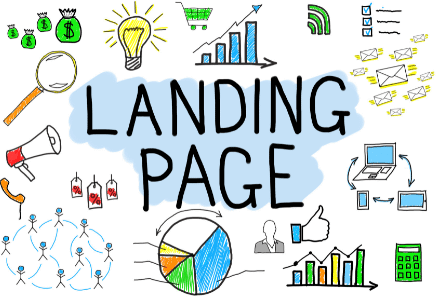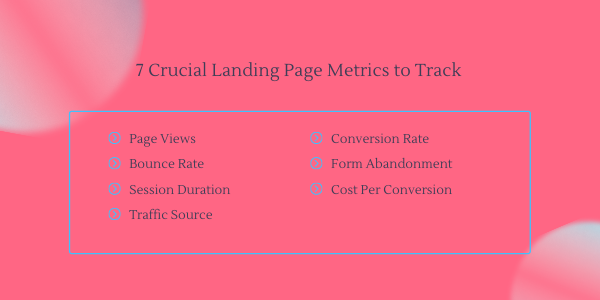Page Contents
Monitoring your landing page metrics will help you develop a more effective landing page. You can find out what’s working and what’s not by tracking the correct metrics.
It’s easy to consider a high number of views or clicks as a sign of success, but what if these are just vanity metrics? Is it possible to delve deeper and redefine landing page success?
You must know which analytics to track and test the landing page with the proper metrics in order to find out if your landing pages have been successful. You’ll be able to obtain a better knowledge of which analytics matter if you regularly monitor the success of your landing page. You can change your marketing strategies after you understand how to measure your landing page’s success.
Follow this guide to track and measure them easily. So, let’s start.


What Are Landing Page Metrics?
A landing page metric is a value that shows how well your landing page performs regarding the critical business objectives. Organizations implement these metrics in various ways to assess their progress toward their goals. Whatever your goals are, you need to know how efficiently you are moving toward them so that you can make decisions according to your position.
Just a brief reminder: you can evaluate how relevant a metric is for your goal by using the SMART criteria:
- Is your objective specific?
- Are you able to measure your progress?
- Is the goal possible to achieve?
- Is it relevant to your success?
- When do you think the timing would be to accomplish this goal?
Why Are Landing Page Metrics So Important?
Even the most specific landing pages have lots of different images, headlines, copies, and forms. Each of them has the potential to increase signups, downloads, or conversions.
Tracking your landing page analytics allows you to improve them over time, matching your message with your audience’s demands. It also repairs any holes in your signup funnel, shopping funnel, and so on. Plus, you’ll earn a better return on your investment.
Most Importantly, this procedure lets you avoid mistakes in your landing page testing. Therefore, you won’t worry about hurting your conversion rate and profit due to a lousy design.
What Is the Key Indicator of a Good Landing Page Conversion?
How can you tell if your landing page’s conversion rate is high enough? In terms of conversion rate, high is a relative phrase heavily influenced by the industry, marketing, and goals.
The average conversion rate is 2.35 percent across all industries. However, you should be aware that there is a significant disparity between the best and poorest performers: the top 10% convert at about five times the average. To create a reasonable target, you should research the typical conversion rate in your business.
Benchmarking your site’s performance can provide insight into how well it is functioning. However, determining what develops a “good” conversion rate can be difficult. As a result, you should have a big picture of your performance and analyze it using numerous landing page metrics.
Source: www.wordstream.com/
7 Crucial Landing Page Metrics to Track
So, what are these metrics we have talked about through this article? Let’s find out.
1. Page Views
When it comes to determining how to measure landing page success, the most obvious factor is the number of page views. If people do not look at your page, your marketing efforts are not succeeding. When analyzing your traffic, make sure to track both total page views and new page views. This helps you track unique visitors as well. Understanding the number of page visits can help you figure out which of your visitors are new and returning to the landing page after a previous visit.
2. Bounce Rate
While most online designers analyze their site’s total bounce rate, tracking this data for particular landing pages is also crucial.
Bounce rate measures the percentage of visitors who leave your site without doing anything extra, such as clicking a link or filling out a form. Your bounce rate is practically the flipside of your conversion rate when it comes to a single landing page.
A high bounce rate could indicate that your landing page offer is unclear or does not correspond to the ad or email that directed viewers to your landing page link.
3. Session Duration
The length of a user’s session is tied to their bounce rate. It’s not enough to know if they’re leaving your page. You must understand how quickly they’re leaving. If your average session lasts only a few seconds, you’re probably not doing enough to grab a user’s attention and give them the information they need. If your bounce rate is high despite a long session duration, maybe you are providing a confusing or annoying user experience. Too much content can also have the same result. Therefore, the length of a session can measure the success of a landing page.
4. Traffic Source
You need to know where your leads are coming from if you’re running campaigns across different channels. If sponsored social media ads drive most of your page’s traffic, you should consider increasing your spending on those platforms. If email campaigns are driving a lot of traffic to your landing page, you might want to try it again in the future. Spend your money where there is a return.
5. Conversion Rate
Conversion rate indicates how many users complete the action that the landing page encourages them to do. After all, landing pages are supposed to be conversion hubs, whether the conversion activity is filling out a form, downloading an asset, viewing a video, making a direct purchase, or arranging an appointment. Landing page conversion tracking is a must-o-do for all businesses.
6. Form Abandonment
You should watch form abandonment closely. The number of users that started filling out the needed information on your landing page and then departed is known as form abandonment.
This can occur due to many reasons. One reason can be that your form asks for too much information or personal details.
7. Cost Per Conversion
Cost per conversion is another vital landing page measure to keep an eye on. It is the expense of acquiring a new lead. Your goal is to increase the conversion rate, not the cost. Keep this in mind in your analyses.


Best Software for Tracking Landing Page Metrics
After all, now is the time to provide you with an answer to solve these problems forever. You need software that helps you keep track of your users in every moment they spend on your website.
We recommend WatchThemLive analytics. Our services provide you with precisely what you need. In this case, our user tracking service can make your life much easier. By using this service, you will watch every movement of your visitors when they are on your landing page. As a result, you’ll have an easier time finding out what is interesting for them and what’s making them leave your website. Also, your design team can make things right by fixing what needs to be changed.
If you need some excellent user tracking software, sign up for FREE right now.
In Conclusion
Here in this article, we tried to define landing page metrics and picture their importance for your business. You were provided with statistics of a good landing page conversion and the ways to achieve it. Lastly, we introduced you to one of the best software in the market for user tracking and website analytics.

